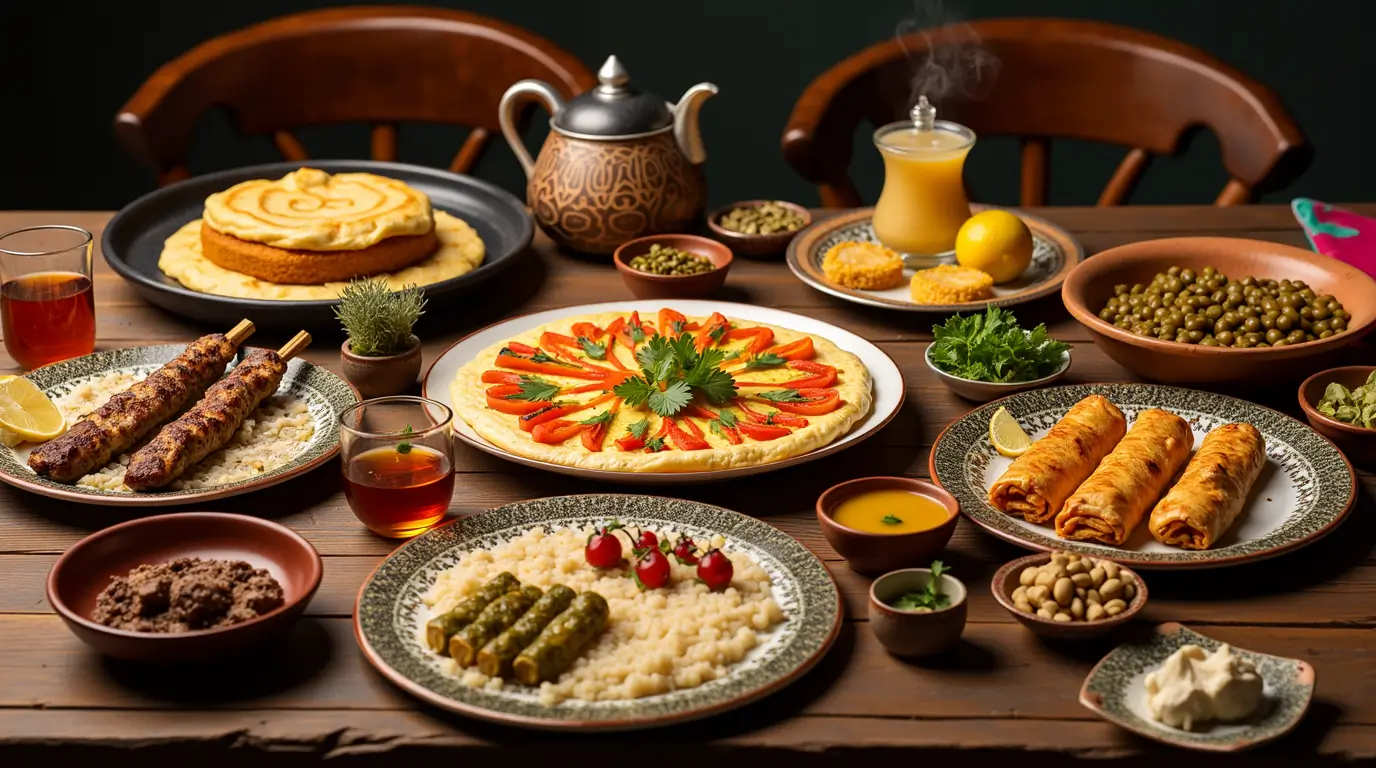Tables of Contents
Introduction
When it comes to Turkey, many people immediately think of its rich history, vibrant culture, and iconic landmarks like the Hagia Sophia or the bustling Grand Bazaar. Yet one of the country’s most remarkable treasures often emerges from its kitchens. Turkish cuisine is a delightful tapestry woven from centuries of tradition, trade, migrations, and cultural exchanges. From the succulent grills of the southeast to the olive-oil-rich vegetable stews of the Aegean coast, the flavors of Turkey are incredibly diverse and reflect the country’s unique geographical position, bridging Europe and Asia.
Although sometimes overshadowed by well-known neighboring gastronomies, Turkish food has a distinct character of its own. It has absorbed influences from the Middle East, the Mediterranean, the Balkans, and Central Asia. Each dish carries within it a historical narrative: spices that traveled the Silk Road, techniques refined in the royal kitchens of the Ottoman Empire, and produce cultivated in fertile regional soils. Over time, this mosaic of influences has crystallized into a cuisine that feels both comforting and surprising—at once familiar and endlessly exciting.
In this article, we will explore the culinary context and history of Turkish cuisine, delve into the key ingredients and local products that define it, and introduce you to its must-try traditional dishes. We will then highlight its defining flavor characteristics, share tips on how to better appreciate this vibrant gastronomy, and shed light on the modern trends shaping the future of Turkish food. By the end, you will understand why Turkish cuisine is loved by so many—and perhaps feel inspired to try it for yourself.
Culinary Context and History of Turkish cuisine
Development Over Time
Turkish cuisine, in its broadest sense, is rooted in the culinary traditions of the Turkic peoples of Central Asia, who historically relied on livestock, dairy products, and hearty grains to survive in nomadic settings. As various Turkic tribes migrated westward, they interacted with Middle Eastern, Byzantine, Persian, and other local cultures, incorporating new foods and techniques into their diets. Over time, the Seljuk Turks established themselves in Anatolia (the Asian part of modern Turkey), creating a fusion of Central Asian and local Anatolian foodways.
However, it was truly under the Ottoman Empire (spanning roughly from the late 13th century to the early 20th century) that Turkish cuisine as we know it began to crystallize. The empire’s vast territory covered the Balkans, parts of the Middle East, and North Africa, facilitating the exchange of ingredients such as eggplants, tomatoes, peppers, coffee, and spices from India and Arabia. Ottoman palace kitchens employed thousands of cooks specializing in different areas—from bakers to kebab masters—who refined and invented dishes that would become staples of modern Turkish cuisine.
After the founding of the Republic of Turkey in 1923, the cuisine continued to evolve. The new nation sought to define its cultural identity, and there was a renewed interest in regional cooking traditions. Over time, increased urbanization, the growth of tourism, and migration within the country led to further cross-pollination of regional recipes and techniques. Today, Turkish cuisine stands at a fascinating crossroads: it remains deeply anchored to tradition while also embracing fresh global influences, particularly in its bustling urban centers like Istanbul, Ankara, and Izmir.
Historical, Cultural, and Geographical Influences
Turkey’s geography is a major factor in shaping its gastronomy. Straddling two continents, Turkey boasts a variety of climates and terrains: the Black Sea region (lush and rainy), the Aegean coast (mild and Mediterranean), the Central Anatolian plateau (dry and continental), and the southeast (hot and arid). Each region contributes its distinct agricultural products, from tea and hazelnuts in the northeast to olives and figs in the west, pistachios in the southeast, and wheat in the heartland.
Historically, Anatolia has been home to numerous civilizations: Hittites, Phrygians, Lydians, Greeks, Romans, Byzantines, and eventually the Ottomans. Each left behind traces of their culinary practices, whether in the form of bread-making techniques, the use of local herbs, or methods of preserving produce. Trade routes, particularly the Silk Road, enabled the exchange of spices, fruits, and vegetables. Coffee, for example, arrived from the Arab world but found its spiritual home in the Ottoman coffeehouses—precursors to modern cafés.
Culturally, the Turkish practice of hospitality plays a significant role. Sharing food is seen as a gesture of friendship and community. Meals are often communal events, and guests are encouraged to eat to their heart’s content. This cultural ethos has helped preserve traditional cooking techniques, as recipes are typically passed down within families. Even in big cities, where modern lifestyles prevail, weekend family gatherings centered around food—like the iconic Turkish breakfast—remain a mainstay.
Major Events and Key Periods
- Seljuk and Early Ottoman Periods: Introduction of Central Asian food traditions and Middle Eastern influences, focusing on meats, rice, bread, and the earliest prototypes of modern kebabs and pilavs (rice dishes).
- Classical Ottoman Era: The empire’s vastness brought in a wider range of spices, vegetables, and fruits. Court cuisine became highly refined, and new dishes emerged, including stuffed vegetables (dolma), layered pastries (börek), and sweet confections like baklava.
- 19th to Early 20th Century: As the empire modernized and eventually dissolved, Western influences began to seep in, adding techniques like baking cakes and pastries. Regional dishes from the Balkans, North Africa, and the Middle East found their way into Turkish towns and cities.
- Republican and Modern Era: Formation of a national identity led to rediscovering Anatolian and regional roots. Rapid urbanization and tourism in the late 20th century spread local dishes nationwide. International culinary trends—such as global fast food and health-conscious eating—have also shaped contemporary Turkish cuisine.
Regional Culinary Differences
- North (Black Sea Region): Known for its rainy climate, the Black Sea region features corn, tea, and hazelnuts. The cuisine is distinct with dishes like muhlama (a thick, cheesy cornmeal porridge) and anchovy-based specialties (hamsi), reflecting the abundance of fish in the Black Sea. Vegetables and leafy greens also play a large role, owing to the lush environment.
- West (Aegean Region): Olive oil is king here, and the cuisine emphasizes fresh vegetables, herbs, and seafood. Dishes are often lighter, with a focus on seasonal produce. In coastal towns like Izmir, you will find meze culture—small plates shared before the main meal—particularly prevalent, showcasing stuffed grape leaves, fresh salads, and fish.
- Central Anatolia: The heartland of Turkey, with a cooler, drier climate. Wheat is fundamental, and therefore bread, noodles (such as erişte), and pastries take center stage. Mantı (tiny dumplings filled with spiced meat) is a celebrated dish here, typically served with yogurt and melted butter.
- East and Southeast Anatolia: Strongly influenced by Middle Eastern and Central Asian flavors, the southeast is the land of robust spices, grilled meats, and hearty stews. Lamb, bulgur wheat, and peppers are staples. Urfa, Gaziantep, and Diyarbakır are famous for their kebabs, spicy red pepper pastes, and sweet baklavas stuffed with pistachios. The eastern region, particularly around Erzurum and Kars, is known for its dairy products and rich, comforting dishes suited to cold winters.
In short, Turkish cuisine cannot be painted with a single brush: it varies dramatically by region and local conditions. However, underlying all these differences is a unifying commitment to freshness, hospitality, and a deep-rooted sense of culinary tradition.
Key Ingredients and Local Products
Emblematic Foods
- Spices and Herbs: While not as spicy-hot as some other cuisines, Turkish cooking uses spices to enhance flavor. Key spices include cumin, paprika (sweet and hot), sumac (a tart, lemony spice), and pul biber (chili flakes). Herbs such as parsley, dill, mint, and oregano are widely used, especially in vegetable and olive oil-based dishes.
- Grains and Legumes: Wheat and its products (bread, börek, and bulgur) are central to Turkish meals. Bulgur, a form of cracked wheat, is key in dishes like kısır (a tabbouleh-like salad) and various pilafs. Rice is also consumed frequently, though wheat is more dominant in many regions. Legumes such as lentils, chickpeas, and beans form the base of soups and stews.
- Meats and Fish: Lamb is traditionally the most prized meat, frequently used in kebabs and stews. Beef, chicken, and goat are also common. Along the coasts, fish and seafood, particularly sea bream, sea bass, and anchovies, are essential. Meat is often accompanied by fresh vegetables and grains, reflecting a balanced approach to meals.
- Vegetables and Fruits: Eggplants, tomatoes, peppers, zucchini, and onions are central to the Turkish kitchen. The country’s varied climate allows for a broad range of produce. Figs, apricots, cherries, and grapes are among the many fruits grown locally. Many dishes are seasonal, with summer bringing fresh produce that becomes the star of the table.
- Dairy Products: Yogurt is ubiquitous, often used as a sauce, side dish, or cooling accompaniment. Cheeses like feta-style beyaz peynir and tangy lor are staples at breakfast. Butter and kaymak (clotted cream) also play essential roles, particularly in desserts and breakfast spreads.
Seasonality and Its Impact
Seasonality is paramount in Turkish cooking, especially in smaller towns and rural areas. Vegetables and fruits are typically purchased and consumed fresh during their peak season, ensuring maximum flavor. In the summer, markets overflow with vibrant tomatoes, peppers, eggplants, and melons. Winter months see the rise of heartier fare like lentil soup, cabbage dishes, and pickled vegetables that preserve summer’s abundance.
Purchasing Tips
- Local Markets (Pazar): Every Turkish city or town has weekly markets where farmers sell their produce. Look for stalls where the vendor’s offerings reflect the season; their goods are likely grown locally and brought in fresh.
- Specialty Stores: For spices, teas, and dried goods, aktar (herbalists/spice shops) are the go-to. They often carry an extensive range of spices, nuts, dried fruits, and herbal blends.
- Online Shopping: For those outside Turkey, many Middle Eastern or Mediterranean grocery stores stock Turkish ingredients. You can also find reputable online retailers that import Turkish staples like pul biber, sumac, or Turkish delight. Just be sure to check product labels for authenticity.
By focusing on fresh, local, and high-quality ingredients, you can recreate many Turkish dishes in your own kitchen—even if you are thousands of miles away.
Must-Try Traditional Dishes
Turkish cuisine brims with iconic dishes that each tell a story of the country’s culinary evolution. Below are some of the must-try classics, along with tips to make them at home or seek out authentic versions.
Kebabs:
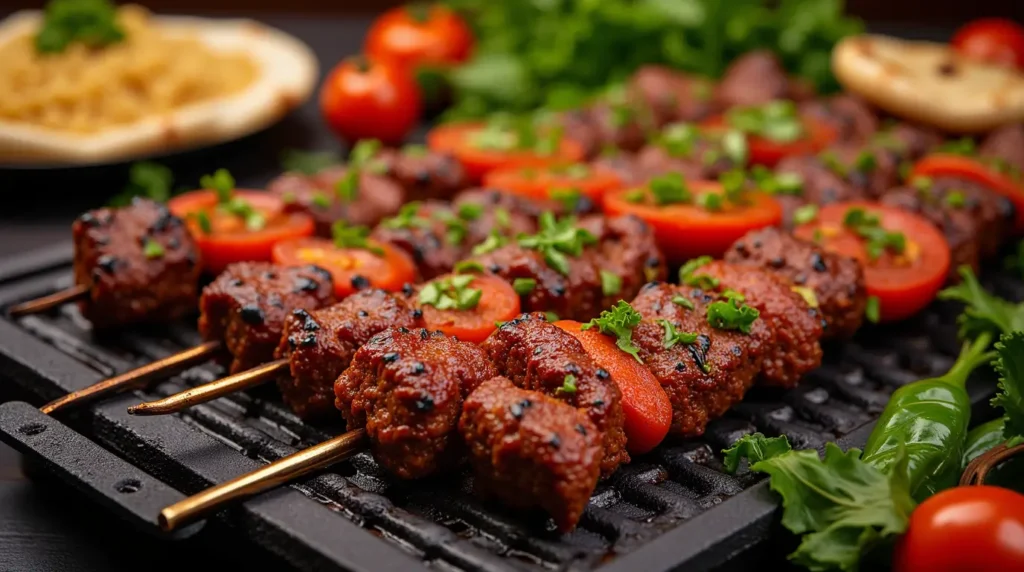
Often the first dish that comes to mind when thinking of Turkish food, kebabs are far more varied than just skewered meat.
Dolma and Sarma:
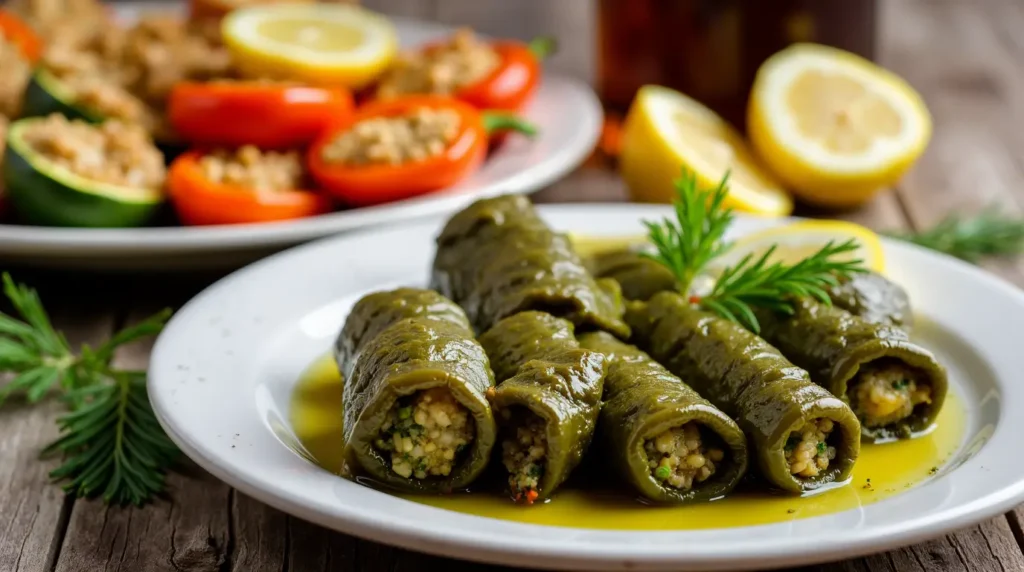
These refer to vegetables (dolma) or vine leaves (sarma) stuffed with a rice-based mixture, sometimes including ground meat, pine nuts, and currants. The vegetarian versions are often served cold and feature fresh herbs and olive oil, while meat-based versions are typically served warm. Dolma’s origins can be traced back to Ottoman palace cuisine, and regional variations abound—peppers, zucchini, eggplants, or cabbage leaves may be used instead of vine leaves.
Börek:
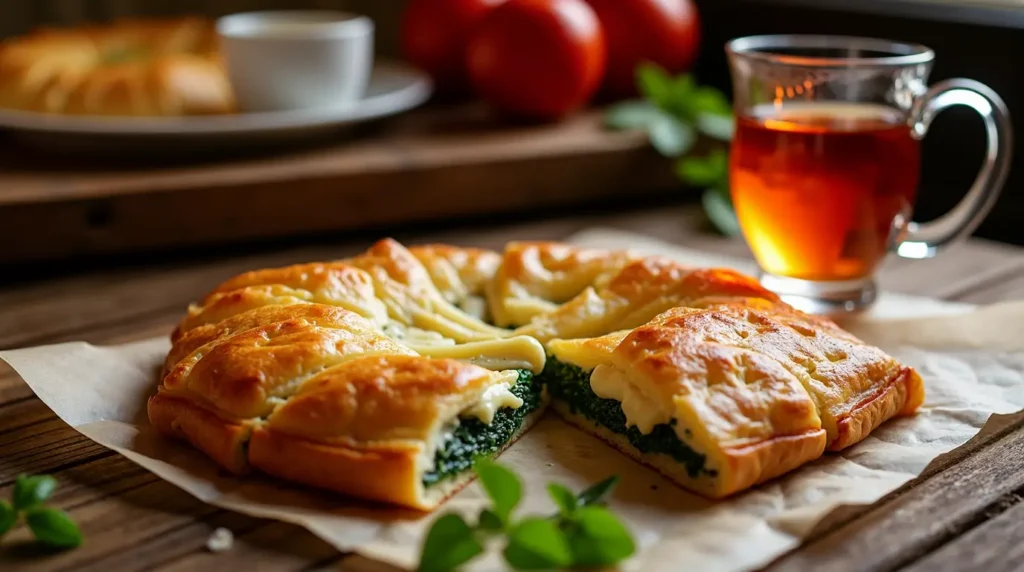
A savory pastry made with thin sheets of dough called yufka, layered or rolled with fillings such as cheese, spinach, or ground meat. Variations include su böreği (a softer, almost lasagna-like version boiled before baking) and ç Böreği (thin layers stuffed with cheese or minced meat). Börek is a breakfast, snack, or tea-time staple throughout Turkey.
Lahmacun:

A thin flatbread spread with a spiced ground meat mixture. It is rolled up with fresh salad and a squeeze of lemon. Popular as street food or a quick meal, these breads show off Turkey’s mastery of baking and layering flavors.
Kuru Fasulye (White Bean Stew):
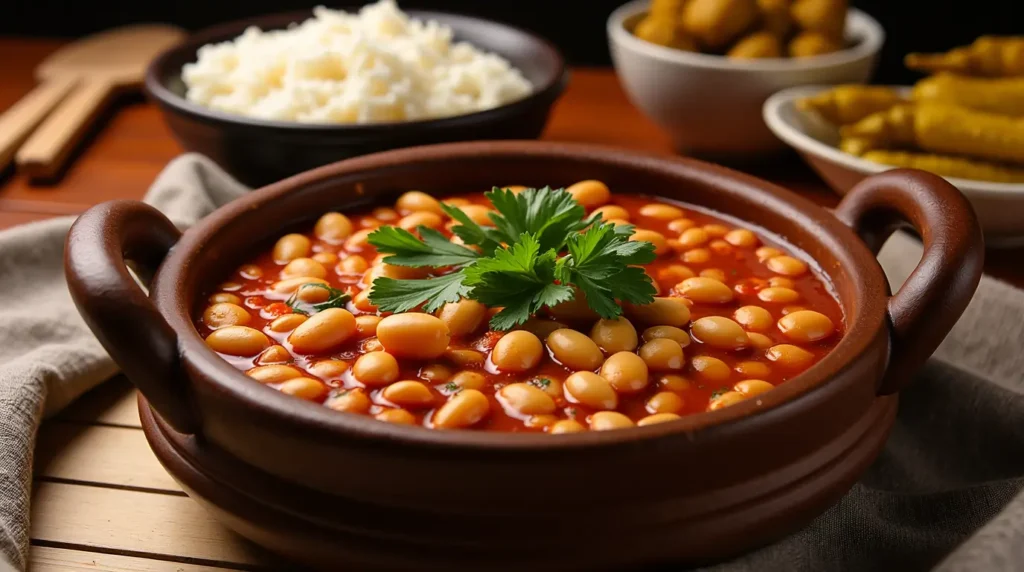
A comforting, home-style dish often served with rice and pickles. White beans are simmered with onions, tomatoes, and sometimes meat or sucuk (spiced sausage) until tender. This stew is a national comfort food, found from simple home kitchens to cafeteria-style lokantas.
Simplified Recipes
Below are two classic dishes you can try at home. They are simplified versions but capture the essence of Turkish flavors.
Menemen
Ingredients
- 2 tablespoons olive oil (or butter)
- 1 onion (optional, finely chopped)
- 1 green pepper (sliced)
- 2 medium tomatoes (diced)
- 3-4 eggs
- Salt and pepper to taste
- Optional: A pinch of pul biber (Turkish chili flakes)
Instructions
- Heat the olive oil (or butter) in a pan over medium heat.
- If using onions, sauté them until they turn translucent.
- Add the sliced green pepper, cooking until softened.
- Stir in the diced tomatoes and let the mixture simmer until the tomatoes break down and release their juices.
- Season with salt, pepper, and optional pul biber.
- Crack the eggs into the pan. Gently stir to incorporate, cooking until the eggs are done to your preference.
- Serve hot with crusty bread.
Easy Lahmacun (Makes 4 lahmacuns)
Ingredients
- 4 ready-made flour tortillas or thin flatbreads
- 200 g ground lamb or beef
- 1 small onion (finely chopped)
- 1 tomato (finely chopped)
- 1 tablespoon tomato paste
- 1 teaspoon paprika or pul biber
- 1 teaspoon cumin
- Salt and pepper to taste
Instructions
- Preheat your oven to 220°C (430°F).
- In a bowl, mix the ground meat, chopped onion, tomato, tomato paste, and spices until well combined.
- Place each tortilla on a baking tray. Spread a thin layer of the meat mixture over the surface of each tortilla.
- Bake for about 5-7 minutes or until the meat is cooked and the edges of the tortilla are slightly crisp.
- Serve hot. Traditionally, you top each lahmacun with parsley, onion slices, and a squeeze of lemon, then roll it up to eat.
Regional Variations
As mentioned, these dishes can differ slightly from one region to another. For example, dolma might be flavored with more spices in the southeast, or lahmacun might include pomegranate molasses in some border regions closer to Syria. Kebabs vary widely by marinade and spice profile. Even seemingly basic dishes like menemen can spark debate on the inclusion of onions or the ratio of peppers to tomatoes. Such variations highlight the adaptability and creative spirit inherent in Turkish culinary tradition.
Whether you are visiting Turkey or trying these dishes at home, it is well worth seeking out these regional nuances. They offer a window into Turkey’s cultural tapestry—a place where shared history meets individual expression, all manifesting in delicious, memorable meals.
Defining Characteristics of Turkish Cuisine
Turkish cuisine is fundamentally about balance. While flavors can be bold—especially in southeastern grills—they are rarely overpoweringly spicy. Instead, the emphasis is on harmonious blends of spices, fresh herbs, and quality ingredients. A typical Turkish meal seeks to please the palate without overwhelming it, allowing each dish’s core ingredients to shine.
Flavor Profiles
- Mild to Moderately Spicy: Pul biber (Turkish chili flakes) is a frequent table companion, but it adds gentle warmth rather than searing heat.
- Aromatic Herbs: Parsley, mint, dill, and oregano lend freshness to salads, stews, and fillings.
- Tangy and Savory Notes: Yogurt-based sauces provide tang, while sumac and lemon juice offer bright, acidic counterpoints.
- Subtle Sweetness: Though Turkish desserts like baklava are quite sweet, sugar is used judiciously in main dishes, often balanced by acidity or spice.
Unique Seasonings and Combinations
- Sumac & Onion: A classic pairing, especially on top of kebabs and lahmacun, giving a slightly tart, earthy flavor.
- Yogurt & Garlic: Found in dips like cacık (similar to Greek tzatziki) or as a sauce for dishes like mantı, reflecting the importance of dairy in Turkish cuisine.
- Pomegranate Molasses: Used in some regional salads, stews, and kebabs, adding a sweet-sour depth that exemplifies Middle Eastern influences.
Because of these well-balanced flavor combinations—neither too sweet nor too salty—Turkish cuisine appeals to a broad range of palates. Food enthusiasts seeking new tastes will find an array of dishes that span from comforting and mellow (like lentil soup or pilafs) to zesty and robust (like spicy Adana kebab). Ultimately, Turkish food offers a culinary adventure brimming with variety, yet unified by a spirit of hospitality and a passion for fresh ingredients.
Tips and Highlights to Encourage People to Try Turkish Cuisine
One of the best ways to fall in love with Turkish cuisine is to experience it among locals—either by visiting Turkey or seeking out Turkish communities and restaurants in your own city. Here are some reasons and tips to spark your culinary curiosity:
- A Feast for the Senses: The vibrant colors of fresh produce, the enticing aromas of spices, and the comforting warmth of fresh-baked bread create an immersive dining experience that appeals to all the senses.
- Hospitality and Sharing: Turkish culture prizes generosity at the table. It’s common to see multiple dishes served family-style, encouraging conversation and a sense of camaraderie.
- Budget-Friendly Options: In Turkey, you can enjoy high-quality dishes at local eateries (known as esnaf lokantası) at very affordable prices. Street foods—like simit (sesame-encrusted bread rings), gözleme (hand-rolled flatbread stuffed with various fillings), or midye dolma (stuffed mussels)—offer a quick and inexpensive taste of tradition.
- Cultural Richness: Trying Turkish cuisine is a journey through centuries of history. Each bite can reveal interesting stories about the Ottoman court, regional migrations, or trade routes—an educational experience as much as a culinary delight.
- Adaptability: There is something for everyone—vegetarian options like vegetable dolma, lentil soups, or bean stews; pescatarian delights in the coastal regions; and rich, meaty dishes for carnivores.
Whether you are sampling the classics at a fine-dining restaurant or savoring street food from a local vendor, Turkish cuisine never fails to impress. With so many culinary gems waiting to be discovered, all it takes is a sense of adventure and an open palate.
Table Rituals and Customs
Typical Meals
- Breakfast (Kahvaltı): In Turkey, breakfast is a festive, leisurely affair, especially on weekends. A typical spread might include bread, butter, various cheeses (feta-style white cheese is standard), olives, tomatoes, cucumbers, jams, honey (often paired with clotted cream called kaymak), and eggs (such as menemen). Tea, served in small tulip-shaped glasses, flows endlessly.
- Lunch (Öğle Yemeği): Traditionally lighter, though in urban settings, people might grab quick bites like a döner sandwich or a plate of home-style cooked dishes at a lokanta. Soups like mercimek çorbası (lentil soup) are also popular.
- Dinner (Akşam Yemeği): The main meal of the day, often featuring several courses—soup, main dish (kebabs, stews, or fish), rice or bulgur, salad, and possibly dessert or fruit. Dinners can be lengthy social events, especially when guests are invited.
- Tea Time (5 Çayı): Borrowed from European influences yet deeply ingrained in Turkish culture, afternoon tea can include sweet pastries, börek, or cakes.
Etiquette Rules and Local Traditions
- Removing Shoes: If you’re invited to someone’s home, you’re typically expected to remove your shoes at the door.
- Serving Guests: The host often insists that guests eat more, refilling plates and encouraging them to taste every dish. Politeness dictates trying a bit of everything offered.
- Bread as a Staple: Bread is sacred and is present at nearly every meal. Wasting bread is frowned upon.
- Sharing Dishes: Meze culture at restaurants is common: small plates are placed in the middle of the table for everyone to sample.
- Gestures to Avoid: Avoid showing the soles of your feet or shoes while seated. It can be considered disrespectful in some traditional households.
National Holidays and Celebrations
- Ramadan (Ramazan) and Eid al-Fitr (Ramazan Bayramı): During Ramadan, families gather for iftar (breaking the fast) each evening, often starting with dates and water. Special breads like pide are baked, and sweets become even more prominent.
- Eid al-Adha (Kurban Bayramı): Marked by the ritual sacrifice of animals, and the distribution of meat to family, friends, and the less fortunate.
- Republic Day (29th October): Celebratory gatherings where friends and family share festive meals, sometimes culminating in fireworks in major cities.
These customs offer a deeper insight into how important food is to Turkish cultural identity. For Turks, eating is rarely just about sustenance; it is a moment of bonding, tradition, and honoring guests and loved ones.
Modern Trends and Culinary Fusions
While Turkish cuisine is deeply rooted in tradition, it is by no means static. The pace of modernization, globalization, and changing consumer tastes have led to new culinary trends and fusions.
Foreign Influences and Fusion Cuisine
Young Turkish chefs, many of whom have trained abroad, are increasingly blending international techniques with local ingredients. Restaurants in Istanbul, for example, may serve “deconstructed mantı” with innovative plating or incorporate Far Eastern flavors into meze spreads. Meanwhile, the city’s vibrant street food scene continues to draw influences from other global cuisines, resulting in creative fusions such as sushi-börek hybrids or kebab-tacos.
New Consumption Trends
- Vegetarian and Vegan Options: Although Turkish cuisine already has a variety of vegetarian dishes (many olive-oil-based stews, lentil soups, and stuffed vegetables are naturally meat-free), a growing number of restaurants now offer dedicated vegetarian and vegan menus.
- Farm-to-Table Movement: Many high-end and boutique restaurants in major cities tout locally sourced, organic produce. Chefs often collaborate directly with farmers to ensure the freshest ingredients.
- Healthy Eating: With obesity and related health issues on the rise, Turks are becoming more conscious about nutrition. Whole-grain breads, salads, and lighter desserts are gaining traction.
Young Chefs and Restaurateurs
Turkey’s gastronomic scene has also seen the rise of young innovators who respect tradition but aren’t afraid to experiment. Some are reviving ancient Anatolian techniques—like cooking in clay pots or using wild herbs—and presenting them in contemporary, upscale settings. Others are rethinking street food, offering gourmet versions of simit sandwiches or lahmacun with novel toppings.
This contemporary wave hasn’t diminished the value of tradition; rather, it showcases the versatility of Turkish cuisine. By combining age-old recipes with modern sensibilities, these new chefs are not only preserving Turkey’s culinary heritage but also ensuring its continued evolution.
Conclusion and Call to Action
In summary, Turkish cuisine is an enticing tapestry of flavors, shaped by centuries of history, diverse cultural interactions, and the bounty of its unique geography. From the hearty kebabs of the southeast to the olive oil-drenched vegetable dishes of the Aegean, every region offers a distinct but equally inviting gastronomic experience. Spices, grains, fresh produce, and dairy all come together in countless combinations, reflecting the central philosophy of balance and hospitality that underpins Turkish food culture.
Whether you’re drawn to the intricate history of Ottoman palace cuisine, the comforting aroma of home-style stews, or the modern fusion experiments of young chefs, Turkey provides endless opportunities for discovery. Now that you’ve explored the highlights—from must-try dishes like menemen and lahmacun to the robust table customs and modern trends—why not take the next step? Try cooking a Turkish meal at home, visit a local Turkish restaurant, or, if possible, travel to Turkey to experience the hospitality and flavors firsthand.
We’d love to hear about your experiences and favorite recipes. Have you tried making menemen or tasting authentic baklava? Do you have questions about specific ingredients or traditions? Share your thoughts, stories, and culinary adventures below. In a future article, we’ll explore the world of Turkish desserts and coffee culture in greater depth, so stay tuned and keep your culinary curiosity alive!

